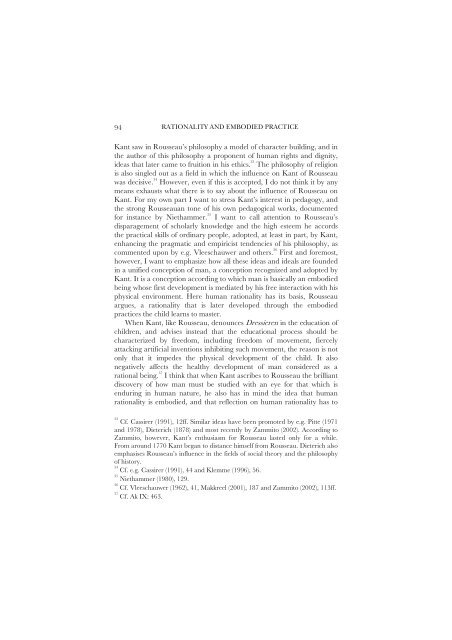BODY AND PRACTICE IN KANT
BODY AND PRACTICE IN KANT
BODY AND PRACTICE IN KANT
Create successful ePaper yourself
Turn your PDF publications into a flip-book with our unique Google optimized e-Paper software.
94<br />
Kant saw in Rousseau’s philosophy a model of character building, and in<br />
the author of this philosophy a proponent of human rights and dignity,<br />
ideas that later came to fruition in his ethics. 33 The philosophy of religion<br />
is also singled out as a field in which the influence on Kant of Rousseau<br />
was decisive. 34 However, even if this is accepted, I do not think it by any<br />
means exhausts what there is to say about the influence of Rousseau on<br />
Kant. For my own part I want to stress Kant’s interest in pedagogy, and<br />
the strong Rousseauan tone of his own pedagogical works, documented<br />
for instance by Niethammer. 35 I want to call attention to Rousseau’s<br />
disparagement of scholarly knowledge and the high esteem he accords<br />
the practical skills of ordinary people, adopted, at least in part, by Kant,<br />
enhancing the pragmatic and empiricist tendencies of his philosophy, as<br />
commented upon by e.g. Vleeschauwer and others. 36 First and foremost,<br />
however, I want to emphasize how all these ideas and ideals are founded<br />
in a unified conception of man, a conception recognized and adopted by<br />
Kant. It is a conception according to which man is basically an embodied<br />
being whose first development is mediated by his free interaction with his<br />
physical environment. Here human rationality has its basis, Rousseau<br />
argues, a rationality that is later developed through the embodied<br />
practices the child learns to master.<br />
When Kant, like Rousseau, denounces Dressieren in the education of<br />
children, and advises instead that the educational process should be<br />
characterized by freedom, including freedom of movement, fiercely<br />
attacking artificial inventions inhibiting such movement, the reason is not<br />
only that it impedes the physical development of the child. It also<br />
negatively affects the healthy development of man considered as a<br />
rational being. 37<br />
I think that when Kant ascribes to Rousseau the brilliant<br />
discovery of how man must be studied with an eye for that which is<br />
enduring in human nature, he also has in mind the idea that human<br />
rationality is embodied, and that reflection on human rationality has to<br />
33<br />
Cf. Cassirer (1991), 12ff. Similar ideas have been promoted by e.g. Pitte (1971<br />
and 1978), Dieterich (1878) and most recently by Zammito (2002). According to<br />
Zammito, however, Kant’s enthusiasm for Rousseau lasted only for a while.<br />
From around 1770 Kant began to distance himself from Rousseau. Dieterich also<br />
emphasises Rousseau’s influence in the fields of social theory and the philosophy<br />
of history.<br />
34<br />
Cf. e.g. Cassirer (1991), 44 and Klemme (1996), 56.<br />
35<br />
Niethammer (1980), 129.<br />
36<br />
Cf. Vleeschauwer (1962), 41, Makkreel (2001), 187 and Zammito (2002), 113ff.<br />
37<br />
Cf. Ak IX: 463.<br />
RATIONALITY <strong>AND</strong> EMBODIED <strong>PRACTICE</strong>
















